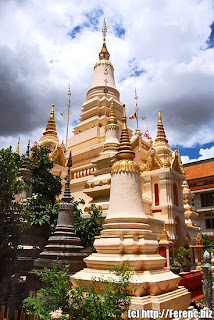Its time for a history lesson.
As most people can barely place
Cambodia on a map, “Uh its somewhere in
Asia…”, I went ahead and assumed that little was known about their history.
But, what a rich history it is!
Following the introduction of Theravada Buddhism in the 13
th century, the infamous Khmer Empire came to power.
Long before the Industrial Revolution, this empire built the world’s largest pre-industrial complex,
Angkor, housing today’s largest religious building, Angkor Wat.
Angkor meaning “capital” and
wat meaning “temple”, Angkor Wat reflects the importance of government and religion in
Cambodia, both which at one point would become corrupt and destroyed throughout its history.
After the fall of the Khmer Empire,
Cambodia fell into years of war between border countries, particularly
Vietnam.
Seeking refuge, King Norodom sought protection from the French, who set up a protectorate government from 1863-1953, giving rise to a myriad of rich French traditions and delicacies in this SE Asian country.
In the years following French protection, Cambodia became a short-lived constitutional monarchy. In a conundrum with the Vietnam and Cold Wars progressing, their communistic Prime Minister, Sihanouk, was booted out of office and replaced with General Lon Nol and Prince Sisowath Sirik Matak. Pissed by this U.S. supported move, Sihanouk began what would ultimately cause a civil war between the Lon Nol government and the Khmer Rouge.
In an attempt to defeat the Viet Cong (the North Vietnamese government, which the
U.S. fought during the Vietnam War) and the Khmer Rouge and with a series of
U.S. bombings along the Cambodian-Vietnam border, the
U.S. actually drove thousands of refuges to flee to
Phnom Penh and support the Khmer Rouge.
In retrospect this sounds crazy, but would you like your leader if he/she was supported by a country that just killed your entire family?
Hmm probably not.
So of course you begin support its opponent- the Khmer Rouge, led by Pol Pot.
 |
Pol Pot- I have nothing nice to say about him, so I just
won't say anything at all. |
Well little did you know, the Khmer Rouge was about to upturn your entire country.
And so much for fleeing to
Phnom Penh.
On April 17
th, 1975 the Khmer Rouge decided that they now ruled the land, invading
Phnom Penh and evacuating the city, telling its residents that the
U.S. was going to bomb the city and safety was located in the country side.
Sneaky little bastards.
Walking miles for days in the brutality of
Cambodia’s hottest month, the weakest began to fade.
At this point it became a game of survival of the fittest.
Now most, if not all, of you have heard and possibly even studied the European Holocaust led by Adolf Hilter. But I’ll bet that nearly none of you know about the Cambodian Genocide- a massacre which led to the deaths of nearly 1/3 of its population.
Pol Pot, often referred to as the Hilter of Cambodia, and his government began by slaughtering all intellectuals- political figures, teachers, doctors, lawyers. All others were forced to work in the fields, dressed in all black uniforms, and fed only 1 cup of rice and a bowl of fish soup a day. While most died from starvation, intellectuals were brutally murdered with blows from metal rods and gun butts, not sparing a single bullet- a valuable item for defeating the Vietnamese forces.
 |
Khmer Rouge soliders leading a man to his death. Don't be
fooled and think he'll use that gun. |
All valuables were destroyed and religion was abolished.
Brains were washed and children were turned into soldiers.
Pol Pot wanted to return
Cambodia to its roots, destroying any evidence of Western influences.
Ironically, he even destroyed parts of Angkor Wat, which to me seems to be the staple of ancient
Cambodia.
Throughout the next 16 years the Khmer Rouge fought to de-evolve its country. However, in 1991, the UN set up United Nations Transitional Authority in Cambodia (UNTAC) and mandated a ceasefire. Unfortunately for many, this was a little too late.
Scholars have estimated that about 2 million Cambodians, of a population of about 7 million, were killed.
Most died of starvation or were murder due to their rank in society or ethnic background.
The Khmer Rouge genocide halted a society that was in the stages of flourishing.
Today
Cambodia, under a constitutional monarchy, still remains a destitute country, relying mostly on its textile industry and tourism.
Glad B and I can help out!
 |
Throughout the country, hundreds of bones may still be found.
As people were murder in mass numbers, most were laid to rest in
mass graves. Today, if you visit the Killing Fields, don't be surprised
if you stumble upon a bone here and there. |
If interested, I would highly recommend reading Loung Ung's First They Killed My Father. As a follow-up her second book Lucky Child is also amazing. But first make sure you have a box of tissues, as you'll inescapably feel connected through her writing, wishing you could stop the inevitable.














































